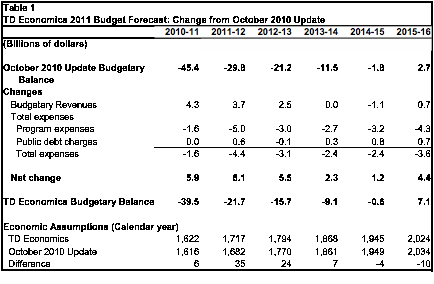TD Economics: Looking Ahead to the 2011 Federal Budget
As we approach Budget Day 2011, private sector forecasters are starting to release their projections of the federal budgetary balance. Should there be an election, these projections could become part of the election debate.
On March 10, TD Economics[1] released their “Looking Ahead to the 2011 Federal Budget”. As shown in Table 1, they forecast lower deficits throughout the entire 2010-11 to 2014-15 period than those forecast in the Minister of Finance’s October 2010 Update of Economic and Fiscal Projections. In 2015-16, they forecast a surplus of $7.1 billion, $4.5 billion higher than that forecast by the Minister of Finance. This should make the Finance Minister extremely happy since the Parliamentary Budget Office (PBO), the International Monetary Fund (IMF), and 3dpolicy have all projected deficits in 2015-16, ranging from $5 to $11 billion. However, a closer examination of TD’s fiscal projections casts doubt on the achievability of a surplus in 2015-16.

Their projection of a surplus in 2015-16 is largely due to their much lower forecast of program expenses, primarily based on their interpretation of the 2011-12 Main Estimates. However, as we reported in our assessment of the Main Estimates[2], over half of the decline was attributable to downward revisions to statutory program expenses, which were already incorporated in the October 2010 Update. In addition, the October 2010 Update forecast of direct program expenses included the impact of the Budget 2010 restraint measures. The Main Estimates for 2011-12 did not provide any new information on statutory program expenses or on aggregate direct program expenses that was not included in the October 2010 Update. The Minister of Finance may come out with revised estimates of program expenses in his upcoming budget, but these will be based on financial developments over the first nine/ten months of 2010-11, revised economic assumptions, and new policy initiatives/restraint measures - none of which were included in the Main Estimates for 2011-12.
The annual average growth in TD’s forecast of program expenses is 1.1 per cent through 2015-16. To achieve such a growth rate would require major cuts to program expenses, something the government has said it would not do at this time.
In addition, both the Parliamentary Budget Officer[3] and ourselves questioned the program expenses profile in the October 2010 Update, claiming unjustified and unexplained adjustments, We believe that program expense track in the October 2010 Update was seriously understated. Since TD’s program expense forecast is much lower, major cuts in transfers to the provinces for health and social spending and also in direct program spending would be required to achieve their projected track.
The TD’s revenue forecast is higher than that of the October 2010 Update to 2012-13, unchanged in 2013-14, slightly lower in 2014-15 and somewhat higher in 2015-16. This profile is somewhat surprising, especially in 2015-16. They are forecasting higher revenues but nominal income is lower than that forecast in the October 2010 Update in that year. Even in the first three years, one would have expected somewhat higher revenues, given the upward revisions to nominal GDP.
However, based on the financial results to the end of December 2010[4], it does not appear that revenues will be higher than forecast in the October 2010 Update for 2010-11. After adjusting for extraordinary developments affecting revenue growth over the first nine months of 2010-11 and in 2009-10 (as identified by the Department of Finance), revenues should be somewhat lower. In contrast, TD expects revenues to be $4.3 billion higher in 2010-11 and they carry part of this forward. If revenues do turn out to be lower in 2010-11, then the TD forecast is at serious risk. In our view, the deficit will be lower by at least $7 billion in 2010-11 but this is due to lower program expenses not higher revenues. How much of this will carry forward is not known at this time.
Based on the above, we do not believe that TD’s current forecast of the budgetary balance is achievable. We continue to believe that there will still be a deficit in 2015-16, unless additional credible restraint measures are undertaken.
[1] Special Report March 10, 2011 “Looking Ahead to the 2011 Federal Budget” TD Economics www.td.com/economics
[2] Main Estimates for 2011-12: They tell us very little about what Government Spending will be” www.3dpolicy.ca March 2011
[3] “How Credible is the October 2010 Fall Economic and Fiscal Update” www.3dpolicy.ca October 2010.
[4] “Deficit for 2010-11 still expected to be $7 billion lower than Forecast” www.3dpolicy.ca February 2011.


Add new comment